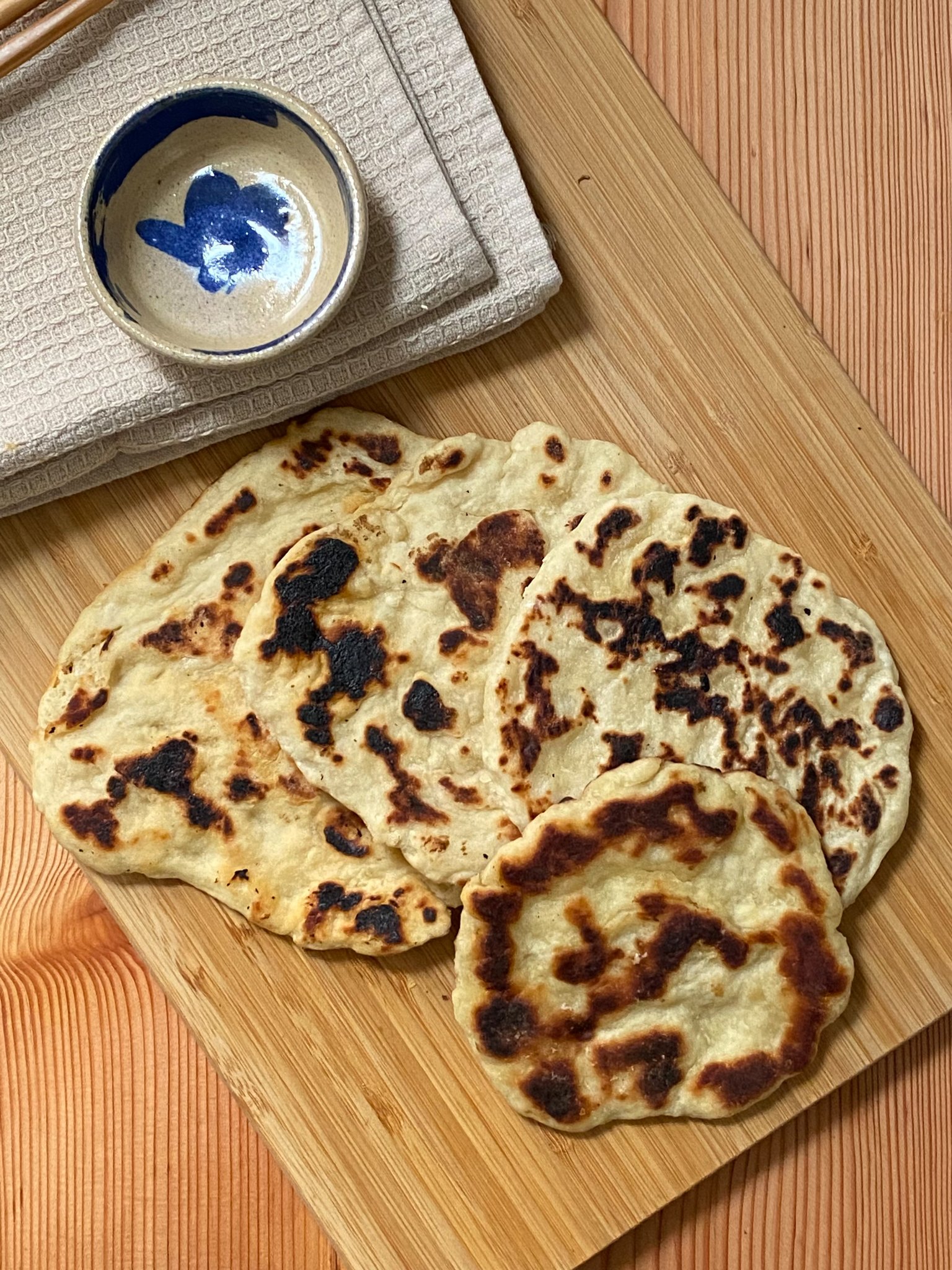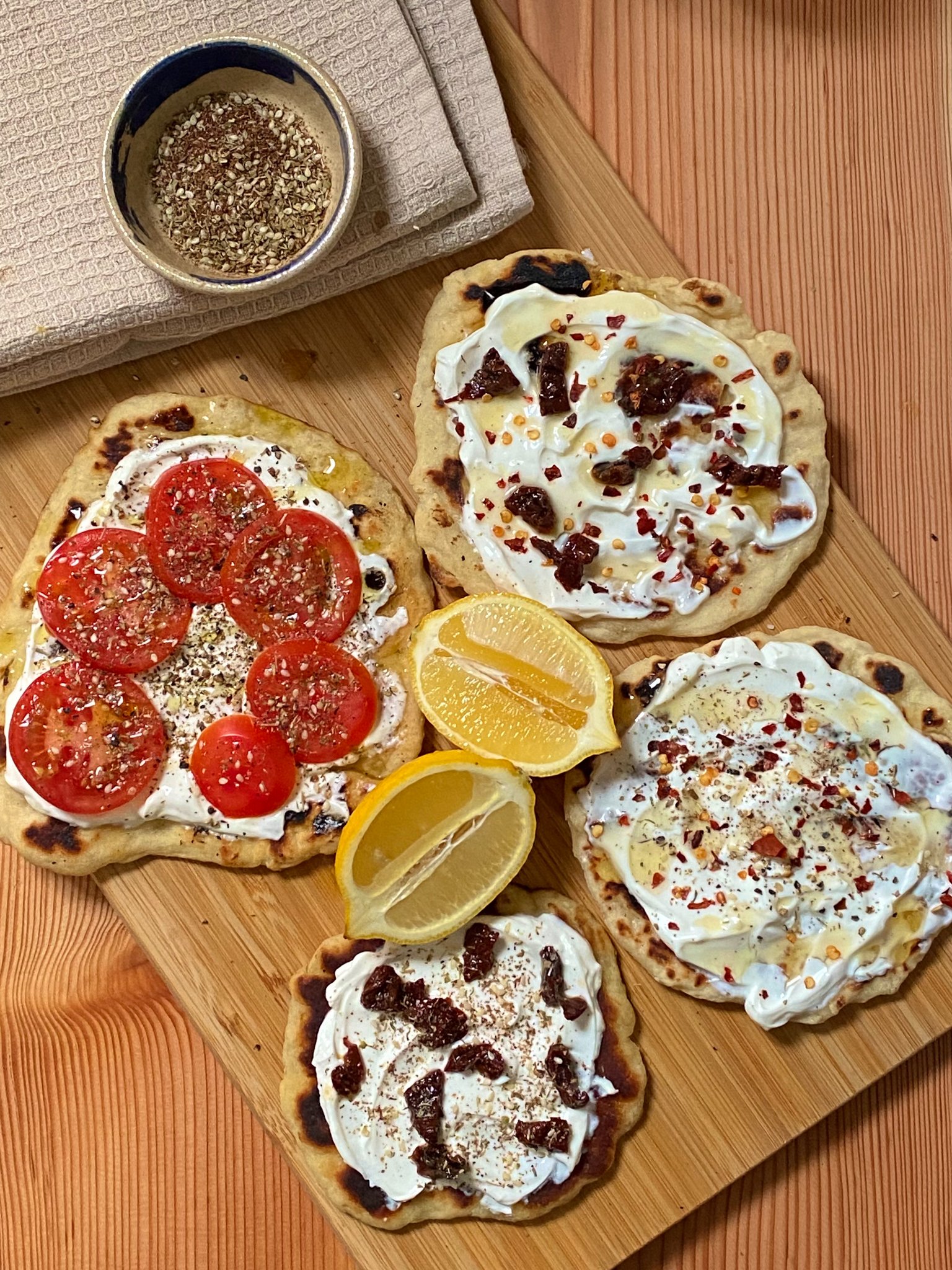Labneh Flatbreads
Sometimes the only thing better than fresh bread is fresh bread you can make in an hour. Pair that with unctuous toppings, and you have a quick, fun, and satisfying dish for you or a crowd.
These flatbreads come together in just over an hour from start to finish, and are the perfect hot, pillow-y canvas for the fattiness of Labneh, the sweetness of honey, the complexity of Za’atar, the brightness of fresh tomatoes, the umami of sun-dried tomatoes, and so much more!
Based around shelf-stable ingredients, this is an awesome back-pocket recipe for any time of the year. Check it out below!
Ingredients
Active Cooking Time: 30min, Total Time: 1hr 15min
Makes 8 Flatbreads
Flat Breads
2 ½ cups All-Purpose Flour: plus more for dusting
¼ oz Dry Active Yeast: one standard packet
½ cup Greek Yogurt: a higher fat percentage will yield a more tender flat bread! If you choose a non-dairy option, make sure it's unflavored and as similar to Greek yogurt as possible. If it is significantly waterier than normal Greek yogurt, use 1/3 cup instead.
2 tsp Kosher Salt
1 ½ tsp Granulated Sugar
2 tbsp Extra Virgin Olive Oil: plus more for bowl greasing
¾ cup Warm Water
Recipe inspired by Bon Appétit
Toppings
Other than the Labneh, the following ingredients can be mixed and matched together however you like. So plan out what you’d like to put on each one and portion accordingly. See the photos below for examples!
1 cup Labneh: If you can’t find it in stores, Labneh can be made from high-fat Greek yogurt. See step one of the preparation to learn how! If you decide to pursue a dairy-free option, vegan cream cheese or hummus are great alternatives! Portion 2 tbsp per flatbread.
Za’atar: roughly 1 tsp per flatbread
Sun-Dried Tomatoes: chopped, roughly 2 tsp per flatbread
Fresh Tomatoes: slices thick or thin based on preference, roughly 1 small tomato or ½ medium tomato per flatbread
Honey: roughly 1 tsp per flatbread
Red Chili Flakes: roughly ¼ tsp per flatbread
Salt: to taste, be sure to sprinkle some over the Labneh and fresh tomato
Black Pepper: to taste
Extra Virgin Olive Oil: to taste
Preparation:
If you’re making your own Labneh, begin two days in advance by placing 1 cup of Greek yogurt in a small colander lined with cheesecloth (or a thin kitchen towel) over a bowl. The yogurt will need 24-36 hours to thicken to the desired consistency.
Once your Labneh is ready (or if it was store-bought), begin making your flatbreads by mixing your sugar, warm water, and dry active yeast in a small bowl and let sit for approximately 10 minutes. The mixture should start foaming in that time.
While the yeast is activating, take a large bowl and mix your flour and salt. Then add in the Greek yogurt and olive oil.
Once the yeast has activated, combine with the flour mixture and mix/knead until the dough comes together. It’s alright if it's a bit flaky and crumbly, but it should come together into a rough ball. Scrape down the sides of the bowl, place another tablespoon of olive oil in the bowl to slick the edges, leave the ball of dough in the center, cover the bowl with a thin kitchen towel, and leave the bowl in a warm spot in your kitchen for approximately 1 hour (or until the dough has roughly doubled in size).
While the dough is rising, prepare your ingredients (chop any tomatoes or sun-dried tomatoes you might use)
Once your dough is ready, scrape it onto a large flour-dusted surface, divide it into 8 pieces, and roll each out into a roughly 6-inch circle.
Add one tbsp of olive oil to a large skillet on medium-high heat, and cook 1-2 flatbreads at a time (depending on the size of the pan), flipping once each side has developed some dark leopard-like spots! Stack the finished flatbreads on a plate with a towel on top until they’re all finished cooking.
Assemble! Start with a layer of Labneh, then add any mixture of the other toppings you desire! Enjoy!
Best Practices:
As always:
As always, try to bring your own bags when you shop, and try to support local producers when possible!
Choose storage containers that will help you make the most of your leftovers!
Opt for buying baking ingredients in bulk whenever possible. This can reduce plastic packaging and save money as well.
These ingredients have been chosen with several things in mind:
Most of these ingredients are shelf-stable pantry staples that are great for using up in the cooler months!
The recipe toppings have been picked as a starting point, but feel free to expand upon them and tweak them to what is available and what is seasonal! For example, fresh tomatoes might be a locally unavailable depending on what time of the year it is, and where in the world you are.
Dairy products can take a big toll on the environment, and should thus be used sparingly when possible! That said, yogurt is an incredible way to extend the shelf life of milk, harnesses the beautiful power of fermentation, and plays a central role in many global cuisines. Keep all of these things in mind when you make your choice to use dairy yogurt or opt for a non-dairy alternative.
Did you enjoy this recipe? Let us know! If you really loved it, share it on social media and tag us (@groundedgrub), or, better yet, share it with your friends and family!




